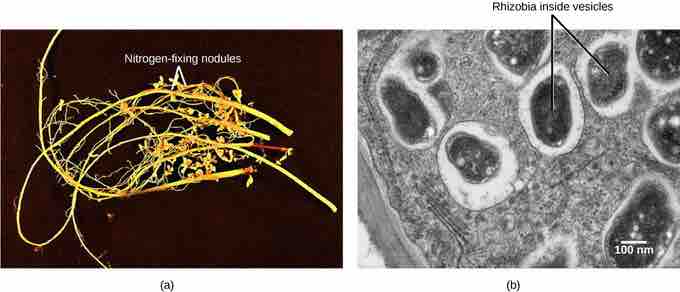Nitrogen Fixation: Root and Bacteria Interactions
Nitrogen is an important macronutrient because it is part of nucleic acids and proteins. Atmospheric nitrogen, which is the diatomic molecule N2, or dinitrogen, is the largest pool of nitrogen in terrestrial ecosystems. However, plants cannot take advantage of this nitrogen because they do not have the necessary enzymes to convert it into biologically useful forms. However, nitrogen can be "fixed." It can be converted to ammonia (NH3) through biological, physical, or chemical processes. Biological nitrogen fixation (BNF), the conversion of atmospheric nitrogen (N2) into ammonia (NH3), is exclusively carried out by prokaryotes, such as soil bacteria or cyanobacteria. Biological processes contribute 65 percent of the nitrogen used in agriculture.
The most important source of BNF is the symbiotic interaction between soil bacteria and legume plants, including many crops important to humans. The NH3 resulting from fixation can be transported into plant tissue and incorporated into amino acids, which are then made into plant proteins. Some legume seeds, such as soybeans and peanuts, contain high levels of protein and are among the most important agricultural sources of protein in the world.

Diagram of the Nitrogen Cycle
Schematic representation of the nitrogen cycle. Abiotic nitrogen fixation has been omitted.

Nitrogen fixation in crops
Some common edible legumes, such as (a) peanuts, (b) beans, and (c) chickpeas, are able to interact symbiotically with soil bacteria that fix nitrogen.
Soil bacteria, collectively called rhizobia, symbiotically interact with legume roots to form specialized structures called nodules in which nitrogen fixation takes place . This process entails the reduction of atmospheric nitrogen to ammonia by means of the enzyme nitrogenase. Therefore, using rhizobia is a natural and environmentally-friendly way to fertilize plants as opposed to chemical fertilization that uses a non-renewable resource, such as natural gas. Through symbiotic nitrogen fixation, the plant benefits from using an endless source of nitrogen from the atmosphere. The process simultaneously contributes to soil fertility because the plant root system leaves behind some of the biologically-available nitrogen. As in any symbiosis, both organisms benefit from the interaction: the plant obtains ammonia and bacteria obtain carbon compounds generated through photosynthesis, as well as a protected niche in which to grow.

Rhizobia
Soybean roots contain (a) nitrogen-fixing nodules. Cells within the nodules are infected with Bradyrhyzobium japonicum, a rhizobia or "root-loving" bacterium. The bacteria are encased in (b) vesicles inside the cell, as can be seen in this transmission electron micrograph.